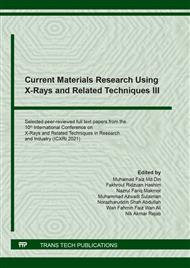[1]
N. Shaari and S. K. Kamarudin: Polym. Test. Vol. 81 (2020), p.106183.
Google Scholar
[2]
F. Galiano, K. Briceño, T. Marino, A. Molino, K. V. Christensen, and A. Figoli: J. Memb. Sci., Vol. 564, no. July (2018), p.562–586.
DOI: 10.1016/j.memsci.2018.07.059
Google Scholar
[3]
A. Grossi, S. De Laia, E. De Souza, C. Júnior, and H. De Souza Costa, in: A study of sodium alginate and calcium chloride interaction through films for intervertebral disc regeneration uses, Brasil (2014), in press.
Google Scholar
[4]
N. Shaari and S. K. Kamarudin: Int. J. Hydrogen Energy, no. xxxx (2018).
Google Scholar
[5]
M. Matet, M. C. Heuzey, A. Ajji, and P. Sarazin: Carbohydr. Polym., Vol. 117 (2015), p.177–184.
Google Scholar
[6]
N. Reddy, R. Reddy, and Q. Jiang: Trends Biotechnol. Vol. 33, no. 6 (2015), p.362–369.
Google Scholar
[7]
A. S. Giz et al.: Int. J. Biol. Macromol. Vol. 148 (2020), p.49–55.
Google Scholar
[8]
M. G. A. Vieira, M. A. Da Silva, L. O. Dos Santos, and M. M. Beppu: Eur. Polym. J., Vol. 47, no. 3 (2011), p.254–263.
Google Scholar
[9]
H. Kaygusuz, E. Torlak, G. Akın-Evingür, İ. Özen, R. von Klitzing, and F. B. Erim: Int. J. Biol. Macromol. Vol. 105 (2017), p.1161–1165.
DOI: 10.1016/j.ijbiomac.2017.07.144
Google Scholar
[10]
M. Gierszewska and J. Ostrowska-Czubenko: Carbohydr. Polym. Vol. 153 (2016), p.501–511.
Google Scholar
[11]
B. R. Riegger, R. Kowalski, L. Hilfert, G. E. M. Tovar, and M. Bach: Carbohydr. Polym. Vol. (2018), p.172–181.
Google Scholar
[12]
J. Rajesh Banu et al. : Bioresour. Technol., Vol. 290 (2019), p.121790.
Google Scholar
[13]
M. Alboofetileh, M. Rezaei, H. Hosseini, and M. Abdollahi: J. Food Eng. Vol. 117, no. 1 (2013), p.26–33.
Google Scholar
[14]
E. Rynkowska, K. Fatyeyeva, J. Kujawa, K. Dzieszkowski, A. Wolan, and W. Kujawski: Polymers (Basel)., Vol. 10, no. 1 (2018).
DOI: 10.3390/polym10010086
Google Scholar
[15]
J. Albo, J. Wang, and T. Tsuru: J. Memb. Sci., Vol. 453 (2014), p.384–393.
Google Scholar
[16]
T. Bourtoom: J. Sci. Technol., Vol. 30, no. SUPPL. 1 (2008), p.149–155.
Google Scholar
[17]
X. Ma, C. Qiao, X. Wang, J. Yao, and J. Xu: Int. J. Biol. Macromol. Vol. 135 (2019), p.240–245.
Google Scholar
[18]
M. Sabbah, P. Di Pierro, M. Cammarota, E. Dell'Olmo, A. Arciello, and R. Porta: Food Hydrocoll. Vol. 87, no. May (2018), p.245–252.
Google Scholar
[19]
R. A. Talja, H. Hele, H. Roos, and K. Jouppila: Vol. 67 (2007), p.288–295.
Google Scholar
[20]
H. Y. Chang and C. W. Lin: J. Memb. Sci., Vol. 218, no. 1–2 (2003), p.295–306.
Google Scholar
[21]
A. S. Aricò, V. Baglio, A. Di Blasi, E. Modica, P. L. Antonucci, and V. Antonucci: Vol. 128 (2004), p.113–118.
DOI: 10.1016/j.jpowsour.2003.09.063
Google Scholar
[22]
L. Atmaja et al.: Malaysian J. Fundam. Appl. Sci. Vol. 15, no. 4 (2019), p.492–497.
Google Scholar
[23]
X. Liao, L. Ren, D. Chen, X. Liu, and H. Zhang: J. Power Sources, Vol. 286 (2015), p.258–263.
Google Scholar
[24]
D. Qiu, L. Peng, X. Lai, M. Ni, and W. Lehnert: Renew. Sustain. Energy Rev. Vol. 113, no. July (2019), p.1–32.
Google Scholar
[25]
Y.-H. Lai, C. K. Mittelsteadt, C. S. Gittleman, and D. A. Dillard: Viscoelastic Stress Model and Mechanical Characterization of Perfluorosulfonic Acid (PFSA) Polymer Electrolyte Membranes, in 3rd International Conference on Fuel Cell Science, Engineering and Technology, May 2005, p.161–167, in press.
DOI: 10.1115/fuelcell2005-74120
Google Scholar
[26]
N. Shaari and S. K. Kamarudin: Int. J. Energy Res. Vol. 43, no. 7 (2019), p.2756–2794.
Google Scholar


